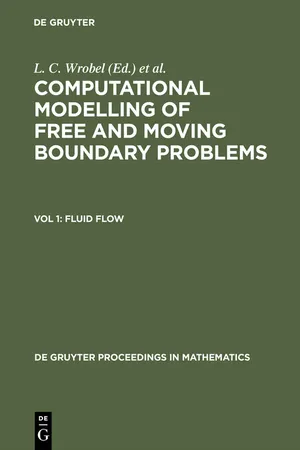
This is a test
- 449 pages
- English
- PDF
- Available on iOS & Android
eBook - PDF
Fluid Flow
Book details
Table of contents
Citations
About This Book
The series is aimed specifically at publishing peer reviewed reviews and contributions presented at workshops and conferences. Each volume is associated with a particular conference, symposium or workshop. These events cover various topics within pure and applied mathematics and provide up-to-date coverage of new developments, methods and applications.
Frequently asked questions
At the moment all of our mobile-responsive ePub books are available to download via the app. Most of our PDFs are also available to download and we're working on making the final remaining ones downloadable now. Learn more here.
Both plans give you full access to the library and all of Perlego’s features. The only differences are the price and subscription period: With the annual plan you’ll save around 30% compared to 12 months on the monthly plan.
We are an online textbook subscription service, where you can get access to an entire online library for less than the price of a single book per month. With over 1 million books across 1000+ topics, we’ve got you covered! Learn more here.
Look out for the read-aloud symbol on your next book to see if you can listen to it. The read-aloud tool reads text aloud for you, highlighting the text as it is being read. You can pause it, speed it up and slow it down. Learn more here.
Yes, you can access Fluid Flow by L.C. Wrobel, C.A. Brebbia in PDF and/or ePUB format, as well as other popular books in Matemáticas & Matemáticas general. We have over one million books available in our catalogue for you to explore.
Information
Table of contents
- Preface
- Contents
- First International Conference on Computational Modelling of Free and Moving Boundary Problems 91
- Section 1: Flow through Porous Media
- Multisplitting and Domain Decomposition Techniques Applied to Free Surface Flow Through Porous Media
- Application of B-Spline Boundary Elements to Groundwater Flow Problems
- Domain Decomposition for Free Boundary Seepage
- Spreadsheet Solution for Transient Fluid Flow in a Porous Media with a Moving Drainage Boundary
- Water Table Aquifers and Finite Element Method: Analysis and Presentation of a Case Study
- Section 2: Wave Propagation
- Wave Motion and Overturning Induced by Moving Bodies: Application to Slender Ship Wave Resistance
- The Modelling of Extreme Gravity Waves: An Approach towards a Numerical Wave Channel
- Time-Domain Simulation of Second-Order Wave Diffraction Around Structures
- Shallow Water Waves
- Numerical Calculation of Surface Waves
- Section 3: Cavitational flow
- A Numerical Approach for Modelling Cavitating Flows
- Boundary Element Simulation of Axisymmetric Cavity Flow Problems
- Cavitation Effects in Journal Bearing having a Big Radial Clearance
- Numerical Study of Cavitational Flows
- Section 4: Free Surface Flow
- Free Surface Flow with Surface Tension
- Dam-Break Wave Routing by Shock Fitting Method
- The Surface Marker Method
- Development of Conveyance Routing
- Solution of Problem of Unknown Boundary in Free Surface Flow Calculations
- The Free Surface Flow Induced by a Submerged Source or Sink from a Three-Layer Fluid
- Free Surface Flow Formed by a Slot Suction
- A Numerical Method for t he Gravity Flow with Multiple Free Surfaces
- Two Open Boundary Conditions for Nonlinear Free Surface Flows
- The Numerical Solution of Viscous Flows with a Free Surface
- Implementing the Boundary Element Method for 2-D Viscous Sintering
- Section 5: Mathematical Problems and Computational Techniques
- A Computational Method for Variational Inequalities
- Optimal Shape Design of a Simple Harbour Model
- Bend Theory of Stream Meanders on a Smooth Plate
- Shock Modeling in Variable Bubble Point Problems of Petroleum Engineering
- Multidimensional Modelling of Uniflow Scavenging in Two-stroke Reciprocating Piston Engines
- Cubic Spline Technique for the Solution of Quasi-Linear Hyperbolic System in Non-Conservative Form